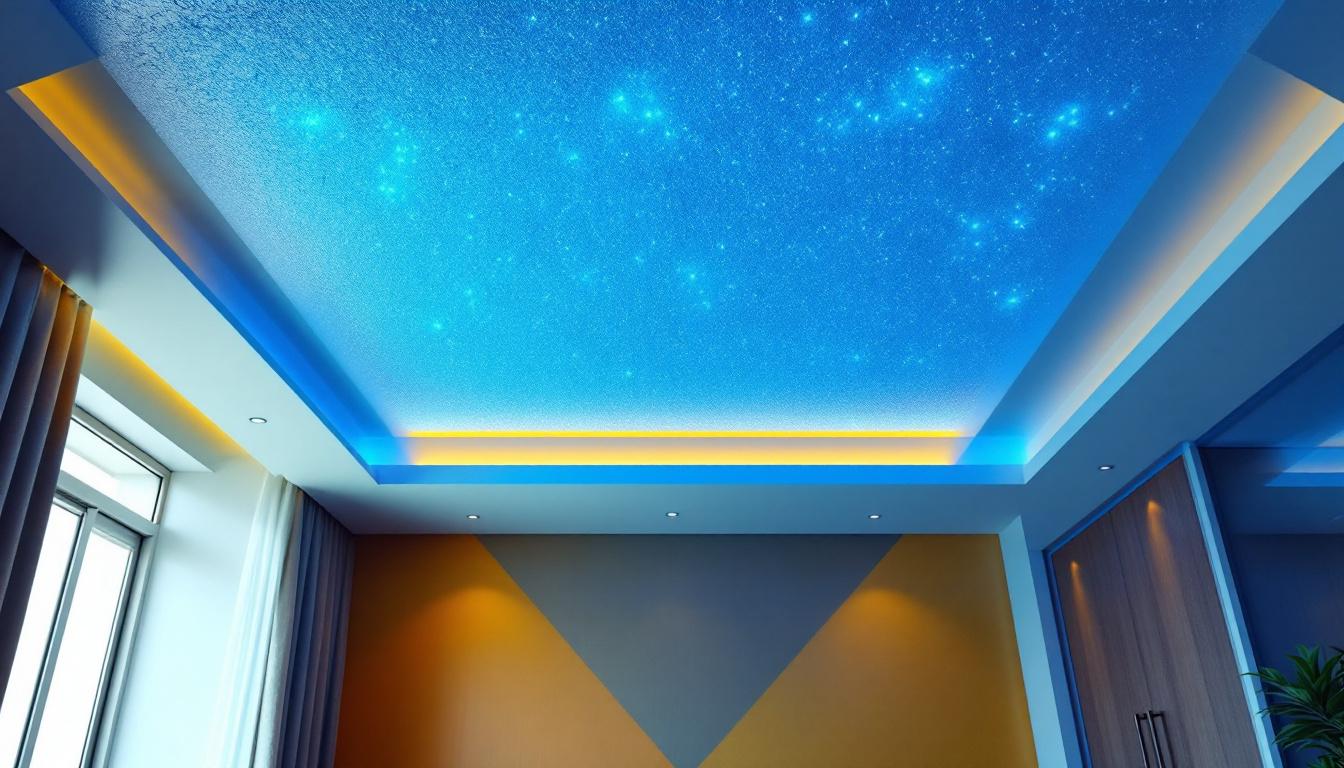
Drop down ceilings, also known as suspended ceilings or false ceilings, are a popular choice in both residential and commercial spaces. They consist of a grid system that supports lightweight panels, creating a space between the ceiling and the tiles. This space can be used for various purposes, including housing electrical wiring, plumbing, and HVAC systems, making them an ideal solution for lighting contractors looking to optimize their installations. The versatility of drop down ceilings allows for easy access to these systems, which is particularly beneficial during maintenance or upgrades, as it eliminates the need for invasive renovations.
For lighting contractors, understanding the cost implications of drop down ceilings is essential. Not only do these ceilings impact the overall budget of a project, but they also influence the choice of lighting fixtures and their placement. A well-designed drop down ceiling can enhance the aesthetic appeal of a space while providing functional benefits, making it a critical consideration in any lighting project. Additionally, the acoustic properties of drop down ceilings can significantly improve the sound quality within a room. By selecting the right materials, contractors can create a quieter environment, which is especially important in spaces such as offices, schools, and healthcare facilities where noise reduction is a priority.
Moreover, drop down ceilings offer a range of design possibilities, allowing for creativity in both residential and commercial applications. From sleek, modern designs with minimalistic panels to more ornate styles that incorporate decorative elements, these ceilings can be tailored to suit any aesthetic preference. Lighting contractors can also experiment with different types of fixtures, such as recessed lighting or pendant lights, to create unique visual effects that complement the overall design. The ability to integrate various lighting solutions into a drop down ceiling not only enhances the functionality of the space but also contributes to energy efficiency, as strategically placed lights can reduce the need for additional illumination.
The cost of installing a drop down ceiling can vary significantly based on several factors. Recognizing these factors allows lighting contractors to provide accurate estimates to clients and make informed decisions during the planning stages of a project.
The materials used in a drop down ceiling can greatly affect its overall cost. Common materials include mineral fiber, metal, and gypsum. Mineral fiber tiles are typically the most economical option, while metal tiles can be more expensive but offer a modern aesthetic. Gypsum boards, on the other hand, provide durability and sound insulation but often come with a higher price tag.
Lighting contractors should consider the specific needs of the project when selecting materials. For instance, if a client desires a high-end look, investing in premium materials may be justified, whereas a budget-conscious project may benefit from more economical options. Additionally, the choice of finish can also influence the cost; for example, tiles with special coatings for moisture resistance or enhanced aesthetics may increase the overall budget. It’s crucial to balance functionality with design preferences to ensure that the final product meets both the client’s expectations and budget constraints.
The complexity of the installation process is another significant cost factor. Simple installations in straightforward spaces will generally incur lower labor costs. However, if the ceiling requires additional features such as custom shapes, integrated lighting, or acoustic treatments, the installation can become more labor-intensive and costly.
Contractors should assess the layout of the space and any potential challenges before providing a cost estimate. Understanding the intricacies involved in the installation process can help in managing client expectations and ensuring a smooth project execution. Moreover, the presence of existing infrastructure, such as ductwork or plumbing, can complicate the installation, necessitating additional adjustments and potentially increasing labor costs. Therefore, a thorough site evaluation is essential to identify any hidden complexities that might arise during the installation phase.
The overall size of the area being covered by the drop down ceiling also plays a crucial role in determining costs. Larger spaces will naturally require more materials and labor, leading to higher expenses. Conversely, smaller projects may benefit from economies of scale, allowing for cost-effective solutions.
Lighting contractors should evaluate the dimensions of the space and consider how the size will impact both material and labor costs. This assessment will enable them to provide clients with a comprehensive understanding of the project’s financial implications. Additionally, the scale of the project can influence the choice of installation techniques; larger areas might benefit from modular systems that can be installed more quickly, reducing labor costs. On the other hand, intricate designs in smaller areas may require more detailed work, which could increase the overall expense. Understanding these dynamics is vital for contractors to deliver tailored solutions that align with their clients’ needs and budgets.
While the costs associated with drop down ceilings can vary, having a general understanding of average prices can aid lighting contractors in budgeting and planning. On average, the cost per square foot for a drop down ceiling installation can range from $2 to $6, depending on the factors previously discussed.
Material costs can fluctuate based on quality and type. For instance, mineral fiber tiles may cost between $0.50 to $2.00 per square foot, while metal tiles can range from $2.50 to $7.00 per square foot. Gypsum boards typically fall within a similar range as metal tiles, but installation costs may be higher due to their weight and handling requirements.
Lighting contractors should be aware of these material costs when advising clients on their options. Offering a range of materials can help clients make informed decisions that align with their budget and design preferences.
Labor costs for installing drop down ceilings can also vary widely. On average, contractors may charge between $30 to $60 per hour for labor, depending on their experience and the complexity of the project. For straightforward installations, labor costs may be lower, while more intricate projects will require skilled labor, leading to higher expenses.
It’s essential for contractors to factor in labor costs when providing estimates to clients. Transparent communication regarding potential labor expenses can foster trust and ensure a smoother project flow.
In addition to material and labor costs, there are other expenses that lighting contractors should consider when estimating the cost of a drop down ceiling. These may include permits, disposal of old materials, and any additional features such as integrated lighting or soundproofing.
Contractors should conduct a thorough assessment of the project to identify any additional costs that may arise. This proactive approach can help avoid budget overruns and ensure that clients are fully informed of the financial implications of their choices.
For lighting contractors, drop down ceilings are more than just a structural element; they are a canvas for creativity and functionality. Understanding the relationship between drop down ceilings and lighting design is crucial for delivering projects that meet client expectations and enhance the overall space.
One of the primary advantages of drop down ceilings is the ability to integrate lighting fixtures seamlessly. With the right design, contractors can create a harmonious balance between the ceiling and the lighting, enhancing the aesthetic appeal of the space. This integration allows for various lighting options, including recessed lighting, pendant fixtures, and track lighting.
Lighting contractors should consider the placement and type of fixtures during the planning stage. A well-thought-out lighting design can elevate the overall ambiance of a room, making it essential for contractors to collaborate closely with clients to achieve their vision.
Drop down ceilings can also play a significant role in managing sound within a space. Many materials used in drop down ceilings offer sound-absorbing properties, which can be beneficial in environments such as offices, schools, and restaurants. By incorporating acoustic tiles, lighting contractors can enhance the overall functionality of the space while also addressing aesthetic concerns.
Understanding the acoustic properties of different materials can help contractors make informed decisions when selecting ceiling tiles. This knowledge can also be a selling point when discussing options with clients, as it demonstrates a commitment to creating a comfortable and functional environment.
As energy efficiency becomes increasingly important in construction and renovation projects, lighting contractors must consider how drop down ceilings can contribute to sustainable practices. The space created by a drop down ceiling can be utilized for energy-efficient lighting solutions, such as LED fixtures, which consume less energy and have a longer lifespan compared to traditional lighting options.
By promoting energy-efficient solutions, contractors can not only help clients save on utility bills but also contribute to environmentally friendly practices. This approach can enhance a contractor’s reputation and appeal to clients who prioritize sustainability in their projects.
Understanding the costs associated with drop down ceilings is essential for lighting contractors looking to deliver successful projects. By considering factors such as material choices, installation complexity, and project size, contractors can provide accurate estimates and make informed decisions that align with client expectations.
Moreover, recognizing the importance of drop down ceilings in lighting design can elevate a contractor’s work, allowing for creative integration of fixtures, acoustic management, and energy-efficient solutions. As the demand for aesthetically pleasing and functional spaces continues to grow, lighting contractors who grasp the significance of drop down ceilings will be well-positioned to thrive in a competitive market.
Ultimately, a comprehensive understanding of drop down ceilings not only enhances the contractor’s skill set but also contributes to the overall success of lighting projects, ensuring that clients receive the best possible outcomes for their investments.
Ready to enhance your lighting projects with the best value in the industry? At LumenWholesale, we provide lighting contractors with exceptional, spec-grade lighting products at unbeatable wholesale prices. Say goodbye to inflated markups and hello to a vast selection of reliable, high-performance lighting that meets the highest industry standards. Plus, with free shipping on bulk orders, you can enjoy premium lighting solutions without hidden fees or compromises. Elevate your drop down ceiling installations and make LumenWholesale your go-to source for quality, affordability, and convenience. Wholesale Lighting at the Best Value is just a click away.

Discover how adhering to OSHA’s industrial lighting standards can give lighting contractors a competitive advantage.

Discover essential insights into lighting diffusers that every lighting contractor should know.

Discover why fluorescent kitchen fixtures are essential for any successful lighting project.

Discover how Electric Switc is revolutionizing smart lighting with innovative contractor approaches.